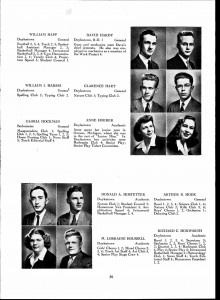 The other day, I was discussing genealogy with a friend and she said to me, “So, genealogy is just one big walk down memory lane?” I thought about this, and while I think that genealogy might be more of a drive down the memory interstate highway, I could not get this idea out of my head. I began to think of how some of us like to mosey down memory lane. For some, this might involve looking through old emails or pulling out a memory box. For me, it means flipping through old yearbooks. Continue reading “Memory lane”
The other day, I was discussing genealogy with a friend and she said to me, “So, genealogy is just one big walk down memory lane?” I thought about this, and while I think that genealogy might be more of a drive down the memory interstate highway, I could not get this idea out of my head. I began to think of how some of us like to mosey down memory lane. For some, this might involve looking through old emails or pulling out a memory box. For me, it means flipping through old yearbooks. Continue reading “Memory lane”
Category Archives: Research Methods
To catch a thief
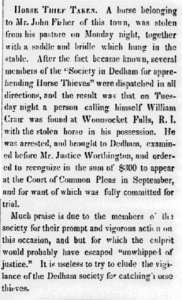
Like many New England towns, my hometown of Dedham, Massachusetts, has a rich history. Though Dedham boasts the Fairbanks House and claims the oldest tax-supported school system in the country, I find one of the town’s most venerable societies to be particularly interesting: The Society in Dedham for Apprehending Horse Thieves.
This Society was founded on 4 June 1810 after a string of horse thefts in the town. Before the establishment of a police force, thirty-five men created their own group in hopes of curbing horse theft in the area. The Society would appoint a select group of men to serve as riders for one year, and were called upon when a horse was stolen. Continue reading To catch a thief
An Alden conundrum
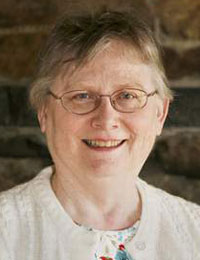 Most family hereditary societies are very small organizations. The Alden Kindred of America was established in 1901, first to protect the Alden homestead in Duxbury, Massachusetts, but second to gather together descendants of the famous Pilgrims John and Priscilla Alden. It currently has fewer than 1,400 members. Modeled after the new Mayflower Society established a few years earlier, the Alden Kindred required that members file lineage papers and proof for their claims, and it had dreams of eventually publishing a full Alden genealogy. However, unlike the Wing Family Association – which has been publishing its magazine The Owl for a century and in time produced a book – the Alden Kindred has not published any significant genealogy. Continue reading An Alden conundrum
Most family hereditary societies are very small organizations. The Alden Kindred of America was established in 1901, first to protect the Alden homestead in Duxbury, Massachusetts, but second to gather together descendants of the famous Pilgrims John and Priscilla Alden. It currently has fewer than 1,400 members. Modeled after the new Mayflower Society established a few years earlier, the Alden Kindred required that members file lineage papers and proof for their claims, and it had dreams of eventually publishing a full Alden genealogy. However, unlike the Wing Family Association – which has been publishing its magazine The Owl for a century and in time produced a book – the Alden Kindred has not published any significant genealogy. Continue reading An Alden conundrum
Tracing ancestral paths: Part Two
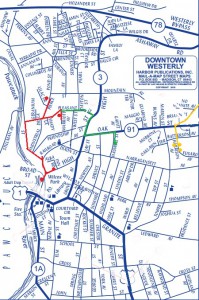
As I mentioned in yesterday’s post, knowing where an ancestor was living within a town at a certain time can be extremely beneficial for a number of reasons. After listing all of the known locations of my ancestors in my hometown of Westerly, Rhode Island, I was able to plot all of these points on a map and see where they had lived and worked. One of the benefits of this knowledge is that, with modern technology, we can see the locations of many of our ancestors’ homes as they stand today. In many cases, the same houses they once occupied may still remain. Websites such as Google Maps, which offer virtual tours of locations around the globe, have greatly expanded the experience of discovering one’s family history. Continue reading Tracing ancestral paths: Part Two
Tracing ancestral paths: Part One
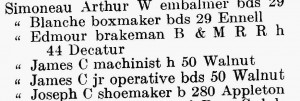
Whether it is collecting, reading, drawing, or painting, maps have always been one of my greatest passions. Therefore, it should come as no surprise that I consider maps an essential tool in my genealogical research. As a researcher, even if I know that some of my ancestors spent their entire lives in the same city or town, I can never assume that they always lived in the same exact location. There are a multitude of sources where an individual’s address at any given point can be found, including: Continue reading Tracing ancestral paths: Part One
Satisfactory accounts
 In my blog post The Wings of a dilemma, I bemoaned the fact that although so much has been published about the Wing family over the years, I could not find a “satisfactory” account of the early Wing family. Raymond Wing of The Wing Family Association has kindly brought me up to speed on what is new with the Wings, including baptisms for the two oldest children of John and Deborah Wing discovered since the 2006 Wing genealogy was published. Thank you, Raymond. These baptisms are posted on the Wing website, but I evidently missed them because I found no link to those records from the other pages on the site to alert me that they were there. This will eventually bring us to discuss the dilemma: “If we have the information, how to we lead people to it?”
In my blog post The Wings of a dilemma, I bemoaned the fact that although so much has been published about the Wing family over the years, I could not find a “satisfactory” account of the early Wing family. Raymond Wing of The Wing Family Association has kindly brought me up to speed on what is new with the Wings, including baptisms for the two oldest children of John and Deborah Wing discovered since the 2006 Wing genealogy was published. Thank you, Raymond. These baptisms are posted on the Wing website, but I evidently missed them because I found no link to those records from the other pages on the site to alert me that they were there. This will eventually bring us to discuss the dilemma: “If we have the information, how to we lead people to it?”
But first, what is, or is not, a “satisfactory” account? Continue reading Satisfactory accounts
What’s in a name: Part Two
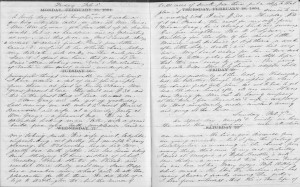
In the coming weeks, I will be reviewing a diary in our collection with an eye toward its eventual publication. The diarist is Hedwiga Regina (Shober) Gray (1818–1885), a native of Philadelphia who married Dr. Francis Henry Gray of Boston (1813–1880) in 1844. As diaries are rarely written with an audience in mind, no matter how remote, Mrs. Gray’s diary – in twenty-five volumes, spanning the years 1860–1884 – is full of interesting mysteries about the identities of the people she encounters. Continue reading What’s in a name: Part Two
“Shake it off!”
 Over the last year or so I have had some interesting matches amongst “DNA Relatives” on the website 23andme.com. I manage the profiles of my parents, my mother’s brother, and my wife’s parents. So far, the most interesting results have all come about from my mother and uncle. While all the profiles have given me several DNA relatives predicted to be anywhere from third to fifth cousins, only my mother and uncle’s matches have been linked me with cousins with whom we have been able to determine the exact degree of the relationship. Continue reading “Shake it off!”
Over the last year or so I have had some interesting matches amongst “DNA Relatives” on the website 23andme.com. I manage the profiles of my parents, my mother’s brother, and my wife’s parents. So far, the most interesting results have all come about from my mother and uncle. While all the profiles have given me several DNA relatives predicted to be anywhere from third to fifth cousins, only my mother and uncle’s matches have been linked me with cousins with whom we have been able to determine the exact degree of the relationship. Continue reading “Shake it off!”
Early New England Families Study Project update
 Seven new sketches were recently posted to the Early New England Families Study Project database on americanancestors.org:
Seven new sketches were recently posted to the Early New England Families Study Project database on americanancestors.org:
Andrew Lane of Hingham, a feltmaker and farmer who had nine children with his wife Trypheny.
George Lane of Hingham, Andrew’s brother, a shoemaker, who had eight children with his wife Sarah Harris.
Oliver Mellowes of Boston and Braintree, farmer. By his first wife, Mary James, Oliver had four children. His second wife was the widow Elizabeth (Hawkredd) Coney – see below. Continue reading Early New England Families Study Project update
Double-dating

Millions of British citizens and their colonial counterparts across the Atlantic Ocean went to sleep on 2 September 1752 and woke up on 14 September. This shift in dates was due to an Act of Parliament passed in 1750, known as Chesterfield’s Act, which put into motion a series of changes that fundamentally altered the way that many measured time. Continue reading Double-dating